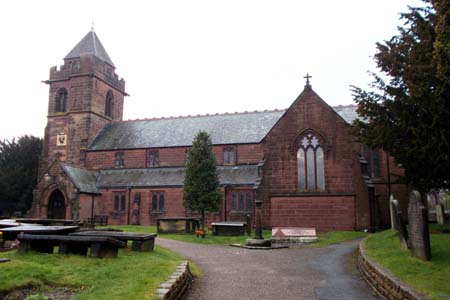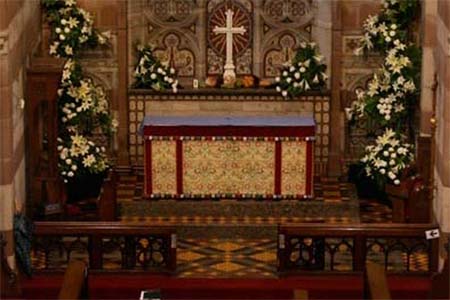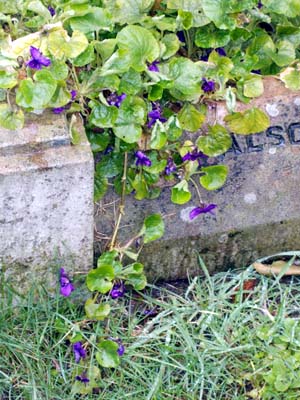| |
 |
 |
 |
| Comment on this report, or find other reports. |
 |
| Our Mystery Worshippers are volunteers who warm church pews for us around the world. If you'd like to become a Mystery Worshipper, start here. |
 |
| Find out how to reproduce this report in your church magazine or website. |
|
|
| 2835: St James, Christleton, England |
 |
 |
 |
Mystery Worshipper: Rustic Lad.
The church: St James, Christleton, Cheshire, England.
Denomination: Church of England, Diocese of Chester.
The building: This sandstone church of 1876 is by William Butterfield, the Victorian architect most associated with Gothic Revival and the Oxford Movement. The churchyard is full of table tombs and yew trees. The tower survives an earlier building dating from 1490. It is hung with a ring of eight bells, six of which sounded as I walked through the lych-gate, making me jump out of my skin! The tower offers some fine views across the Cheshire plain to the Peckforton Hills and beyond. The interior of the church is light and quite pleasing, with a nave and two side aisles. The aisles sport colourful red, black and yellow tiles. There are ten windows by the Victorian artist Charles Eamer Kempe, whose works are considered among the finest stained glass to be found anywhere. There were two candles on the altar, whose frontal was correct in liturgical red (as were the priest’s vestments). In the south aisle the Lady chapel is separated from the choir by a wrought-iron screen that originally separated the nave from the chancel. In the west end are churchwarden’s pews with canopy in ebonised wood.
The church: Judging by the contents of the parish magazine, this church appears to play a prominent part in the community. There are a lunch club, youth group, messy church for the little ones, affiliation to Church Missionary Society. There are flower arrangers, choir, and bell ringers.
The neighbourhood: Christleton, on the outskirts of Chester, has been called the best kept village in Cheshire. With pubs sporting names such as the Ring O'Bells and the Cheshire Cat, it's not hard to see why. The village was mentioned in the Domesday Book and was probably settled before that. Celia Fiennes, who pioneered the notion of travel for its own sake (especially by women), passed through here in 1685; her unpublished memoirs became the model for later travelogues. (She is depicted in the Millennium Window in church.) Today there is a village store, two hair salons, an old people’s home, and a dental practice. White-washed cottages with gardens rub shoulders with more modern dwellings. Traffic noise from the busy A41 road is quite noticeable.
The cast: Celebrant was the rector, the Revd Malcolm Cowan, assisted by the Revd Barbara King, curate.
The date & time: Palm Sunday, 29 March 2015, 10.45am.
What was the name of the service?
Holy Communion with Palm Procession.
How full was the building?
About three-quarters full: 60 in the congregation, including a handful of children.
Did anyone welcome you personally?
I had looked forward with eager anticipation to this service for Palm Sunday with the promise of a donkey procession, as billed in the parish magazine. Having donned my finest Sunday attire, I hot-footed it to church through the driving wind and rain of a very inclement morning, and was disappointed: there was no donkey. This was the start of English summer time, the clocks having gone forward one hour, and it was chucking it down! The service was advertised for 10.45am but didn't get underway until close to 11.00. Time crept on. Six bells rang out across the village. A few ladies with heads bent into the wind shook their umbrellas over me and deposited them in the church porch. A man, shaking the drops off his, glared at me and gave me the once-over without uttering a word. The bells having ceased, I went inside. A sidesperson said "Good morning" as he handed me a palm cross (ready made; I prefer to fashion my own out of fronds), hymn book, and service booklet. I found a seat in the nave and settled myself in.
Was your pew comfortable?
Not comfortable. The pews were too shallow, not deep enough for modern physiques, and the pew runner ended up on the floor a couple of times. It could have done with being anchored by someone else’s physique at the other end.
How would you describe the pre-service
atmosphere?
Quite a bit of talking, volume level rising and falling, but trailing off after the organ began to play. Still no sign of the donkey; perhaps he was rained off.
What were the exact opening words of the
service?
“Please, can we stand.” Here the choir and clergy processed up the nave, led by the crucifer, singing “Ride on, ride on in majesty” (but ride what, I wanted to know: still no donkey) to a tune I didn’t know.
What books did the congregation use during the
service?
Pew Bibles were the New International Version. We used a booklet entitled Holy Communion for Palm Sunday that was taken from Common Worship. The hymn book was Hymns Ancient and Modern (New Standard). We also juggled a pew sheet and the palm cross.
What musical instruments were played?
A two-manual pipe organ in the north aisle of the choir. Originally by the Victorian organ builder George Maydwell Holdich, it was rebuilt in 1990 by the Liverpool firm of Rushworth and Dreaper.
Did anything distract you?
I kept peering about me, half expecting to see a pair of long furry ears and the whiskery muzzle of Eeyore making a late appearance.

Was the worship stiff-upper-lip, happy clappy, or
what?
Mediocre, broad church, low key affair. Quite disappointing really, but maybe this is the way they do things at St James. Is it St James the Less, perhaps?
Exactly how long was the sermon?
No sermon; we were led straight from the gospel into the creed.
Which part of the service was like being in
heaven?
Well, my rain-soaked shoes had dried off quite nicely. Bliss and joy!
And which part was like being in... er... the other place?
Where, I wondered, was the triumphant entry of Our Lord into Jerusalem, with or without the donkey? It felt very flat – no atmosphere. I also discovered that one of my dental restorations had come adrift. Unfortunately, greater distress was caused to one of the male choristers, who collapsed over the altar rail at communion. Fortunately someone hastened to his aid and soon an ambulance arrived with attendant paramedics.
What happened when you hung around after the service looking lost?
The final hymn, "All glory, laud and honour," was pitched so low I thought the church phones would start ringing with villagers enquiring about the sonic boom. After the service, everyone seemed to be doing their own thing. I felt a bit spare. The choir nipped back into the choir stalls to rehearse the Easter music. Service booklets were collected up. The stricken chorister had recovered a bit and was being attended to by the paramedics. Someone had lost an umbrella: "Well, I definitely left it in the porch and it’s gone.” According to the pew sheet, refreshments were available. But were there really, or had they gone the way of the donkey and the sermon? I wandered out into the dripping churchyard, where I spotted a nice clump of Viola odorata and listened to a robin singing.

How would you describe the after-service
coffee?
I discovered that refreshments had been on offer after all, but they were all gone by the time I got there.
How would you feel about making this church your regular (where 10 = ecstatic, 0 = terminal)?
5 –
I wouldn’t feel inclined to make it my regular church. I prefer something a little more robust.
Did the service make you feel glad to be a
Christian?
No, it did not. Maybe I expect too much from churches that I do not regularly attend. I found it a bit impersonal. However, it is a lovely building within a good setting – nice for weddings.
What one thing will you remember about all this in seven days' time?
The red velvet altar frontal and vestments.
|
|
|
 |
 |
 |
| We rely on voluntary donations to stay online. If you're a regular visitor to Ship of Fools, please consider supporting us. |
 |
 |
 |
| The Mystery Pilgrim |
 |
| One of our most seasoned reporters makes the Camino pilgrimage to Santiago de Compostela in Spain. Read here. |
 |
 |
 |
| London churches |
 |
| Read reports from 70 London churches, visited by a small army of Mystery Worshippers on one single Sunday. Read here. |
| |
|
|
|
|


